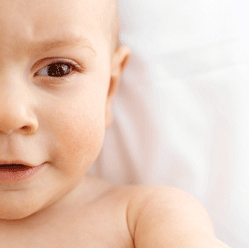Infant ear infections

An ear infection is caused by a buildup of fluid in the middle ear. As the pressure in the ear builds, so does the hurt factor, ranging from a dull ache to a sharp, stabbing pain. Many ear infections are accompanied by an upper respiratory infection. A change in elevation, allergies, and irritants like cigarette smoke are also factors that can contribute to ear infections. Bacteria cause some infections, while viruses cause others.
How can I tell if my baby has an ear infection?
Ear infections are often accompanied by a fever, but not always—other symptoms include general fussiness, restlessness, showing signs of pain while sucking, frequent shaking of the head, and ear pulling (although ear pulling can also be attributed to a number of other factors, one of which is teething). Ear infections should always be diagnosed by a medical professional, so make an appointment with your pediatrician if you suspect your little one has an earache.
What can I do to prevent ear infections?
There’s no way to guarantee that she won’t develop an ear infection, but providing a healthy lifestyle for your child by feeding her healthy foods, dressing her appropriately, and making sure that she gets the rest she needs will promote overall good health. And you shouldn’t expose your child to known stimulants, like cigarette smoke.
How do I treat my baby’s ear infection?
A doctor should always recommend treatment for ear infections in infants—antibiotics might be necessary and most pediatricians will also OK the use of acetaminophen to relieve pain. In the past, the drug amoxicillin was frequently used to treat ear infections, but due to an increase in resistance to the bacteria of certain medications, doctors have been scaling back on the use of antibiotics—so don’t be surprised if your doctor doesn’t automatically recommend medicine. And not all ear infections—such as those caused by a virus—can be treated with antibiotics. A warm (but not hot) heating pad held over the ear can help relieve discomfort, and keeping your baby upright will allow the fluid to drain and help ease painful pressure.
Why do babies get so many more ear infections than adults do?
It’s all about the Eustachian tube, which connects the middle ear to the back of the nose and throat. Fluid typically moves through this tube pretty quickly when your baby yawns or swallows, but if it’s blocked—normally due to a cold or allergies—the fluid becomes trapped and bacteria begins to breed. Since babies have short, horizontal Eustachian tubes (about 1/2 inch, as opposed to an adult’s 1 1/2 inch, vertical tube), fluid doesn’t drain as easily and is more likely to build up, causing infection.
[Fact:] Ear infections are most common between December and March.







